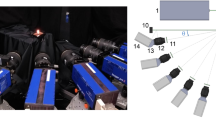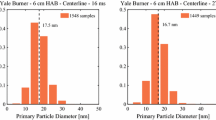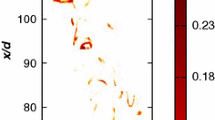Abstract
The spatial distribution of soot aggregate size and morphology within a premixed flat flame (McKenna-type burner and ethyne–air mixture at an equivalence ratio of Φ = 2.7) is characterized by two-dimensional multi-angle light scattering (2D-MALS). A profound investigation of such an extended, radially symmetrical sooting flame with 2D-MALS requires a sophisticated camera calibration to correct for non-linear image scaling and a careful evaluation of the scattering data. Sharp scattering images were acquired in the angular range from 20° to 155° using a rotatable camera system and an automated Scheimpflug adapter. To correct for non-linear variations in horizontal and vertical image magnification occurring at scattering angles differing from perpendicular view, a polynomial-based image transformation algorithm was developed to convert all scattering images into a common coordinate system. Effective radii of gyration and fractal dimensions of soot aggregates were then derived from scattering data by two different approaches. Due to limited amount of angular positions, the classical method based on Guinier and power law analysis shows limitations, as it yields discontinuous results, predominantly in axial direction of the burner. Bayesian analysis was then used for a data fit of the complete structure factor conducting a least square minimization leading to more consistent results. The use of prior knowledge in the Bayesian evaluation allows for improved data fitting and reduced uncertainties in radius of gyration and fractal dimension even for small aggregate sizes.











Similar content being viewed by others
References
E.J. Highwood, R.P. Kinnersley, Environ. Int. 32, 560–566 (2006)
K.-H. Kim, S.A. Jahan, E. Kabir, R.J.C. Brown, Environ. Int. 60, 71–80 (2013)
M. Lippmann, Crit. Rev. Toxicol. 44, 299–347 (2014)
T.C. Bond, S.J. Doherty, D.W. Fahey, P.M. Forster, T. Berntsen, B.J. DeAngelo et al., J Geophys Res D 118, 5380–5552 (2013)
V. Ramanathan, G. Carmichael, Nat. Geosci. 1, 221–227 (2008)
J. Hansen, L. Nazarenko, Proc. Natl. Acad. Sci. USA. 101, 423–428 (2004)
M. Frenklach, PCCP 4, 2028–2037 (2002)
R.J. Pugmire, S. Yan, M.S. Solum, Y.J. Jiang, A.F. Sarofim. 9th International Congress on combustion by-products and their health effects (2005)
H.A. Michelsen, Proc. Combust. Inst. 36, 717–735 (2017)
H. Richter, J.B. Howard, Prog. Energy Combust. Sci. 26, 565–608 (2000)
H. Wang, Proc. Combust. Inst. 33, 41–67 (2011)
S.R. Forrest, T.A. Witten, J. Phys. A Math. Gen. 12, L109–L117 (1979)
R.A. Dobbins, C.M. Megaridis, Langmuir 3, 254–259 (1987)
Ü.Ö. Köylü, Y. Xing, D.E. Rosner, Langmuir 11, 4848–4854 (1995)
R.J. Samson, G.W. Mulholland, J.W. Gentry, Langmuir 3, 272–281 (1987)
A.M. Brasil, T.L. Farias, M.G. Carvalho, J. Aerosol Sci. 30, 1379–1389 (1999)
C. Oh, C.M. Sorensen, J. Aerosol Sci. 28, 937–957 (1997)
C.M. Sorensen, Aerosol Sci. Technol. 35, 648–687 (2001)
M. Wozniak, F.R.A. Onofri, S. Barbosa, J. Yon, J. Mroczka, J. Aerosol Sci. 47, 12–26 (2012)
F.J.T. Huber, S. Will, K.J. Daun, J. Quant. Spectrosc. Radiat. Transf. 184, 27–39 (2016)
M. Altenhoff, C. Teige, M. Storch, S. Will, Rev. Sci. Instrum. 87, 125108 (2016)
A.M. Vargas, Ö.L. Gülder, Rev. Sci. Instrum. 87, 055101 (2016)
P.-J. De Temmerman, E. Verleysen, J. Lammertyn, J. Mast, Powder Technol. 261, 191–200 (2014)
S.C. Wang, R.C. Flagan, Aerosol Sci. Technol. 13, 230–240 (1990)
Y. Endo, N. Fukushima, S. Tashiro, Y. Kousaka, Aerosol Sci. Technol. 26, 43–50 (1997)
K. Ehara, C. Hagwood, K.J. Coakley, J. Aerosol Sci. 27, 217–234 (1996)
K. Park, F. Cao, D.B. Kittelson, P.H. McMurry, Environ. Sci. Technol. 37, 577–583 (2003)
M.M. Maricq, S.J. Harris, J.J. Szente, Combust. Flame 132, 328–342 (2003)
J.E. Brockmann, Aerosol transport in sampling lines and inlets (Wiley, Hoboken, 2011)
C. Saggese, A. Cuoci, A. Frassoldati, S. Ferrario, J. Camacho, H. Wang et al., Combust. Flame 167, 184–197 (2016)
C. Schulz, B.F. Kock, M. Hofmann, H. Michelsen, S. Will, B. Bougie et al., Appl. Phys. B 83, 333–354 (2006)
H.A. Michelsen, C. Schulz, G.J. Smallwood, S. Will, Prog. Energy Combust. Sci. 51, 2–48 (2015)
H. Geitlinger, T. Streibel, R. Suntz, H. Bockhorn. Symposium (International) on Combustion, vol. 27 (1998), pp. 1613–21
S. Gangopadhyay, I. Elminyawi, C.M. Sorensen, Appl. Opt. 30, 4859–4864 (1991)
Ü.Ö. Köylü, G.M. Faeth, J. Heat Transf. 116, 152–159 (1994)
Ü.Ö. Köylü, G.M. Faeth, J. Heat Transf. 116, 971–979 (1994)
C.M. Sorensen, J. Cai, N. Lu, Langmuir 8, 2064–2069 (1992)
O. Link, D.R. Snelling, K.A. Thomson, G.J. Smallwood, Proc. Combust. Inst. 33, 847–854 (2011)
R.J. Santoro, H.G. Semerjian, R.A. Dobbins, Combust. Flame 51, 203–218 (1983)
P. Hull, I. Shepherd, A. Hunt, Appl. Opt. 43, 3433–3441 (2004)
S. De Iuliis, F. Cignolia, S. Benecchi, G. Zizak, Proc. Combust. Inst. 27, 1549–1555 (1998)
H.R. Haller, C. Destor, D.S. Cannell, Rev. Sci. Instrum. 54, 973–983 (1983)
H. Oltmann, J. Reimann, S. Will, Combust. Flame 157, 516–522 (2010)
H. Oltmann, J. Reimann, S. Will, Appl. Phys. B 106, 171–183 (2012)
F.J.T. Huber, M. Altenhoff, S. Will, Rev. Sci. Instrum. 87, 053102 (2016)
M. Bouvier, J. Yon, G. Lefevre, F. Grisch, J. Quant. Spectrosc. Radiat. Transf. 225, 58–68 (2019)
F.J.T. Huber, S. Will, J. Aerosol Sci. 119, 62–76 (2018)
S. Will, S. Schraml, A. Leipertz, Opt. Lett. 20, 2342–2344 (1995)
S. Will, S. Schraml, A. Leipertz, Proc. Combust. Inst. 26, 2277–2284 (1996)
J. Reimann, S.A. Kuhlmann, S. Will, Appl. Phys. B 96, 583–592 (2009)
B. Ma, M.B. Long, Appl. Phys. B 117, 287–303 (2014)
N.J. Kempema, M.B. Long, Combust. Flame 164, 373–385 (2016)
A.R. Jones, Light Scattering in Combustion (Springer, Berlin, 2006)
C.F. Bohren, D.R. Huffman, Absorption and Scattering of Light by Small Particles (Wiley, New York, 1983)
C.M. Sorensen, N. Lu, J. Cai, J. Colloid Interface Sci. 174, 456–460 (1995)
M.Y. Lin, R. Klein, H.M. Lindsay, D.A. Weitz, R.C. Ball, P. Meakin, J. Colloid Interface Sci. 137, 263–280 (1990)
U. von Toussaint, Rev. Mod. Phys. 83, 943–999 (2011)
D.W. Burr, K.J. Daun, O. Link, K.A. Thomson, G.J. Smallwood, J. Quant. Spectrosc. Radiat. Transf. 112, 1099–1107 (2011)
J. Kaipio, E. Somersalo, Statistical and Computational Inverse Problems (Springer, New York, 2006)
F. Migliorini, S. De Iuliis, F. Cignoli, G. Zizak, Combust. Flame 153, 384–393 (2008)
R. Stirn, T.G. Baquet, S. Kanjarkar, W. Meier, K.P. Geigle, H.H. Grotheer et al., Combust. Sci. Technol. 181, 329–349 (2009)
Acknowledgements
The authors gratefully acknowledge funding by the German Research Foundation (DFG) under Grant no. WI 1602/6-1. We thank Rolf Eigenheer and Charlie Gfeller of GFAE GmbH Switzerland for their operating assistance and hardware improvements of the CAPcam Scheimpflug adapter. We are grateful to Julia Kufner, Robert Müller, Andreas Knerr, and Nicolas Fechter for their help concerning the ELS measurements and evaluation strategies.
Author information
Authors and Affiliations
Corresponding author
Additional information
Publisher's Note
Springer Nature remains neutral with regard to jurisdictional claims in published maps and institutional affiliations.
This article is part of the topical collection “Laser-Induced Incandescence”, guest edited by Klaus Peter Geigle and Stefan Will.
Appendix
Appendix
1.1 Derivation of the image calibration function
To find a suitable calibration function with minimum deviations and fast processing speed, we examined polynomial functions for different polynomial degrees n from one to 15. Figure 12 shows the maximum deviations and standard deviations in x- and y-directions for polynomial degrees 1 ≤ n ≤ 15 calculated for all marker points in the region of interest for all 41 angles following the procedure described in Sect. 3.2.
For an increasing polynomial degree, the coordinates of the marker points are mapped more precisely according to their set point positions. Both the maximum deviations and the standard deviations for x- and y-directions are decreasing with increasing polynomial degree, whereby the deviations in y-direction are a little lower than in x-direction. A maximum degree of seven seems suitable for both spatial dimensions, as deviations are only slightly decreasing for higher polynomial degrees. Moreover, higher polynomial degrees should be handled with care, as they might lead to oscillations between sampling points and thus wrong mapping. Besides, higher degrees result in more terms and, therefore, in an extended processing time for image transformation. For example, a polynomial degree of 15 needs 816 terms to be solved, while a degree of seven only needs 120 terms and can be processed by hardware around 15 times faster based on MATLAB calculations. For further reduction of terms and improvement of calculation time, we successively reduced the number of maximum allowed polynomial degrees pmax and qmax for the x- and y-variables, respectively, down to a minimum of one, keeping rmax = n for the angular variable. This approach follows the idea of an almost linear behavior in x- and y-imaging. The maximum deviations as well as standard deviations in both x- and y-directions are shown in Fig. 13.
Both maximum and standard deviation in x-direction are relatively independent of the maximum polynomial degree pmax between two and seven; in y-direction, the maximum deviation obtains minimum values towards lower degrees qmax. The standard deviation in y-direction is very small for any degree qmax. Consequently, we chose a customized polynomial calibration function of degree seven with 39 individual terms in total omitting terms with degree pmax ≥ 3 and qmax ≥ 2 with high computational efficiency.
1.2 Uncertainty in the extinction correction
A profound derivation of Rg,eff and Df from light scattering in sooting flames requires a correction for extinction caused by laser attenuation and signal trapping. However, the height-specific extinction coefficients used in this work are derived from a simplified approach (see Sect. 3.4 for further details) and thus afflicted with uncertainties, which also affect a reliable determination of Rg,eff and Df. Figure 14 shows the deviations in Rg,eff and Df derived from Bayesian inference including prior knowledge along the radial axis at two different HAB with a conservative estimation of the uncertainty of the extinction coefficient α of ± 10%. Besides, Rg,eff and Df were also derived from scattering without any extinction correction.
Rg,eff (left) and Df (right) derived from Bayesian inference including prior knowledge along the radial axis at 10 mm HAB (solid lines) and 20 mm HAB (dashed lines) for the determined extinction coefficient α (black lines) and the regions of uncertainty for each HAB (grey areas). Additional results for a 10% overestimation of α (blue lines) and a 10% underestimation of α (red lines), as well as results determined without extinction correction (thick dark red lines)
Without extinction correction, the values for Rg,eff along radial extent in the ROI (between −20 and 20 mm radial extent and 10 mm and 20 mm HAB) are underestimated by up to 43% or overestimated by up to 28%. At 10 mm HAB, aggregate sizes would exhibit a monotonous decrease in the radial direction, at 20 mm HAB aggregate sizes on the left flame side with R < 0 mm are within the range of uncertainty (grey area), but strongly decrease for R > 0 mm. At 10 mm HAB, the fractal dimensions show no significant deviations outside the region of uncertainty, as they are mainly based on prior knowledge. At 20 mm HAB, however, Df is overestimated by up to 24% for R < 0 mm.
Assuming a reasonable, yet conservative uncertainty of ± 10% in the extinction coefficient, deviations in Rg,eff and Df within the ROI are below 5% and thus smaller than the uncertainty obtained from Bayesian analysis of the scattering data.
Rights and permissions
About this article
Cite this article
Altenhoff, M., Aßmann, S., Perlitz, J.F.A. et al. Soot aggregate sizing in an extended premixed flame by high-resolution two-dimensional multi-angle light scattering (2D-MALS). Appl. Phys. B 125, 176 (2019). https://doi.org/10.1007/s00340-019-7282-0
Received:
Accepted:
Published:
DOI: https://doi.org/10.1007/s00340-019-7282-0







